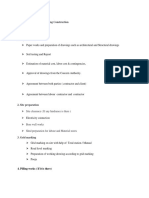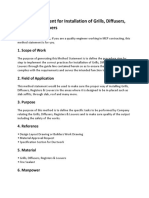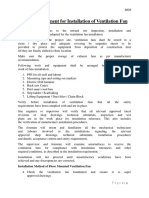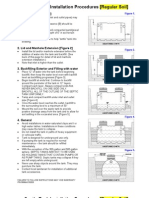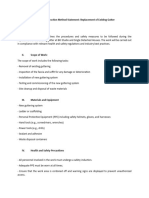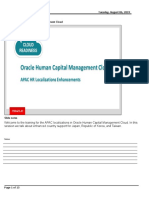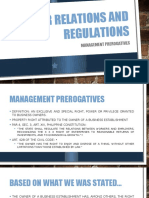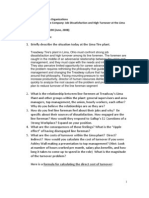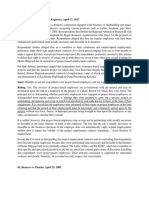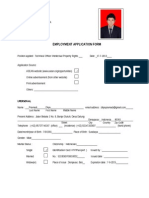Assignment 1
Assignment 1
Uploaded by
Темные ЧеловекOriginal Description:
Copyright
Available Formats
Share this document
Did you find this document useful?
Is this content inappropriate?
Report this DocumentCopyright:
Available Formats
Assignment 1
Assignment 1
Uploaded by
Темные ЧеловекCopyright:
Available Formats
TABLE OF CONTENTS
CONTENTS
PAGES
INTRODUCTION JOB SAFETY TYPES OF PIPES PLUMBING HANDTOOLS PLUMBING POWER TOOLS PLUMBING FITTING CONCLUSION REFERENCES
1 1 7 10 12 13 14 14
|KKTM SG
KOLEJ KEMAHIRAN TINGGI MARA SRI GADING, BATU PAHAT
1.0
INTRODUCTION
The plumbing system in your home is composed of two separate subsystems. One subsystem brings freshwater in, and the other takes wastewater out. The water that comes into your home is under pressure. It enters your home under enough pressure to allow it to travel upstairs, around corners, or wherever else it's needed. As water comes into your home, it passes through a meter that registers the amount you use. The main water shutoff, or stop, valve is typically located close to the meter. In a plumbing emergency, it's vital that you quickly close the main shutoff valve. Otherwise, when a pipe bursts, it can flood your house in no time. If the emergency is confined to a sink, tub, or toilet, however, you may not want to turn off your entire water supply. Therefore, most fixtures should have individual stop valves.
2.0
JOB SAFETY
2.1
IMPORTANCE OF SAFETY ON JOB
Safety is important at a workplace, also because human resources are the most important resources of an organization. Safety at a workplace, also known as office safety refers to the safety of this valuable resource of an organization. Satisfied employees can earn for a company what money can't buy. Human life is priceless. It cannot be made up for, by monetary compensations. An employer might be able to substitute an employee by another. But, not necessarily his dedication and expertise. That's why it's important for organizations to understand that human resoures are its assets. This is also a reason why employers should cater to workplace safety, and moreover, to the employees' lives.
1|DCM 4063
KOLEJ KEMAHIRAN TINGGI MARA SRI GADING, BATU PAHAT
2.1.1 PERSONAL PROTECTIVE EQUIPMENT a. Eye Protection Safety Goggles and Face Shields are just the beginning of a comprehensive eye protection program. Choosing the correct eye protection to the proper application is key to reducing eye injuries in the workplace.
b. Hand Protection Hand protection can have a significant impact on an employee's job performance considering most industrial jobs are done using the hands. Years ago, the design of hand protection gloves would interfere with a workers performance of certain tasks. Nowadays, there are many styles of safety gloves to choose from and are specifically engineered to do a particular job with much more comfort than ever.
c. Foot Protection Employees should be aware of any and all potential hazards and wear the appropriate footwear to protect against them. Employers therefore need to asses all areas, determine the potential hazards and mandate protective footwear accordingly.
d. Ear Protection Hearing loss is a serious problem for workers in an industry that exposes them to unsafe noise levels. Unfortunately, it is a very common work related problem. Hearing loss is permanent and not reversible. Wearing hearing protection can make the condition totally preventable.
2|DCM 4063
KOLEJ KEMAHIRAN TINGGI MARA SRI GADING, BATU PAHAT
e. Inhalation Protection The industrial environment dictates the type of respirator, and/or respirator cartridges needed to protect worker's lungs and/or face. An effective respirator has to fit comfortably with a secure seal and not allow the tiniest particles to enter the breathing area inside the respirators mask.
f. First Aid Kit
First Aid is usually defined as the initial care given for an injury of illness. It does not include surgery or other education intensive procedures and is instead usually performed by a lay person until professional medical treatment facilities can be provided.
g. Safety Helmet
Workers are always exposed to head injury and should be provided the necessary protective head gear. Protection from falling objects, lateral protection for striking against low hanging objects and protection against electrical head hazards should be provided by the employer as part of their safety program.
3|DCM 4063
KOLEJ KEMAHIRAN TINGGI MARA SRI GADING, BATU PAHAT
2.1.2 GENERAL SAFETY a. Ladder Safety
1. Extend ladder 3' above the surface 2. Tie off ladder at top 3. 3-point contact at all times when climbing ladder 4. Don't use if ladder has broken rungs 5. For every 4' in height put ladder 1' back 6. Secure ladder at bottom 7. Never carry tools or materials on ladder
4|DCM 4063
KOLEJ KEMAHIRAN TINGGI MARA SRI GADING, BATU PAHAT
b. Electrical Safety
Never do anything that would break the conductor's insulation. Do not, for example, staple an extension cord to a baseboard or wall. The staple can cut through the insulation and create a short circuit, which, in turn, can start a fire. Moreover, you should examine all wiring regularly and discard any cord with brittle insulation. Replace the old cord with a new one that has good insulation. Turn the power off before replacing a receptacle or a switch or doing any other work on a circuit. If your system operates with fuses, remove the fuse for the circuit you're working on and slip it into your pocket or toolbox. When you work on an electrical circuit, make all wire joints and connections inside an approved electrical box. There are several ways to join wires, but the best way is to use solder less connectors of either the crimp-on or screw-on wire nut kind. Never connect wires together in a behind-the-wall or in-the-ceiling location that is not accessible by simply opening an electrical box. In addition, when joining insulated wires to one another or when fastening them under terminal screws, make sure no uninsulated or bare wire extends beyond the connection. The insulation should go right up to the solder less connector or terminal screw. One of the best ways to join wires is to use solder less connectors called wirenuts. Twist the conductor ends together, and screw the wirenut into the twisted ends. Make sure no bare conductor is exposed. Everyone in the family should know where and how to throw the master switch that cuts off all electrical current. If there's a chance of contact between water and electricity, do not wade in water until the master switch has been shut off. Always assume an electrical receptacle or apparatus is energized until you prove otherwise with a circuit tester or by pulling a fuse or tripping the disconnect plug. Use only insulated pliers when working with electricity. Stand on a dry board or wooden platform when working with a fuse box or circuit breaker box. Also, use a wooden rather than an aluminum stepladder to minimize the risk of shock when working with electrical wiring. You can save time by determining which electrical circuits activate which receptacles in your home and then diagramming or printing the information inside the circuit breaker or fuse box.
5|DCM 4063
KOLEJ KEMAHIRAN TINGGI MARA SRI GADING, BATU PAHAT
c. Scaffold Safety Securing Scaffold frames (i.e. bucks) must be joined together vertically by coupling or stacking pins (or equivalent means). Scaffolds with a height-to-base width ratio of more than four to one shall be restrained from tipping over by guying, tying, bracing, or equivalent means. Guys, ties and braces shall be installed where horizontal members support both inner and outer legs. Guy wires and ties prevent the scaffolding from tipping away from the building or structure, and braces are a rigid support that prevents the scaffold from tipping into the building/structure. Vertical Securing If the base width is wider than three feet, the first tie will be a vertical distance of four times the base width and every 26 feet vertically thereafter. For example, if the base width is 5 feet, the first vertical tie will be (5 feet x 4) 20 feet from the ground. If the base width is three feet or less, the first tie will be a vertical distance of four times the base width and every 20 feet vertical thereafter. For example, if the base width is three feet, the first vertical tie will be (3 feet x 4) 12 feet from the ground. Horizontal Securing For long (running) scaffolds, guys, ties, and braces shall be installed at each end of the scaffold and at horizontal intervals not to exceed 30 feet.
6|DCM 4063
KOLEJ KEMAHIRAN TINGGI MARA SRI GADING, BATU PAHAT
3.0
TYPES OF PIPES
1. TYPES OF HOUSEHOLD WATER SUPPLY PIPES
a. Copper Pipe Used for decades as the most common water supply pipe. Copper pipe and tubing comes in a variety of sizes and types. Type L - Thick walled hard/soft copper Type M - Thin walled hard/soft copper Type K - Thick walled hard/soft copper
b. PVC Used as a cold water supply pipe in many countries around the world because of the price but lacks long term durability.
c. CPVC Used as a hot/cold water supply pipe in many countries around the world because of the price but lacks long term durability.
7|DCM 4063
KOLEJ KEMAHIRAN TINGGI MARA SRI GADING, BATU PAHAT
d. PEX Is cross-linked polyethylene tubing and has become the standard in new home construction. PEX comes in a variety of colors and is used for plumbing and heating purposes.
e. Galvanized Pipe May still be found in many homes but is seldom used anymore because of water discoloration, cost and difficult repairs.
8|DCM 4063
KOLEJ KEMAHIRAN TINGGI MARA SRI GADING, BATU PAHAT
2. TYPES OF HOUSEHOLD DRAINAGE PIPES a. ABS A hard walled black plastic drain pipe used extensively in North America.
b. Cast Iron A very common drain pipe in older homes but is no longer used in residential plumbing.
c. Copper DWV A hard walled copper drain, waste and vent pipe(DWV) that was commonly used in older homes. Still commonly used in commercial and industrial construction, but to pricey for residential.
9|DCM 4063
KOLEJ KEMAHIRAN TINGGI MARA SRI GADING, BATU PAHAT
4.0
PLUMBING HAND TOOLS a. Tape Measure The tape measure will use the same units of measurement that are common with rulers. Often, the tapes produced today will be double sided. One side of the tape will provide measurements in linear increments, while the other side will provide measurements in metric increments. This means that one simple tape measure can function just about anywhere in the world.
b. Levels A spirit level or bubble level is an instrument designed to indicate whether a surface is horizontal (level) or vertical (plumb).
c. Adjustable Wrenches Wrenches are standard, indispensable tools for workmen that facilitate the rotating of bolts, nuts, pipes and other hard-to-turn items. Wrenches sets provide a variety of size, shape and material options to allow these tools to be used in different circumstances. The only drawback with normal wrenches is that one size doesn't fit all and carrying a whole set to a worksite can be tiring and tedious.
10 | D C M 4 0 6 3
KOLEJ KEMAHIRAN TINGGI MARA SRI GADING, BATU PAHAT
d. Plastic Pipe Cutter
Plastic pipe in a way of scissors when people were cutting by saw. The concept through research and development completely changed the world's view the plumbing, irrigation, waterworks, mechanical, and any industries involving plastic pipes. The advantage of using a PVC Pipe Cutter allows for faster, cleaner, and less effort cuts. A socket wrench set is useful for removing recessed packing nuts and for use on tub and shower fixtures as well as other do-it-yourself household repairs. For changing a toilet seat, you'll need a wrench, or perhaps a deep socket wrench. If you need to remove a toilet for replacement or repair, you may need a spud wrench.
e. Pipe Wrench
f. Tubing Cutter The tubing cutter is an essential plumbing tool if you are going to be doing any work with copper pipe. With copper pipe it is important to have smoothly cut and squarely cut ends and well fitted joints.
g. Others
Slip-Joint Pliers - To need an adjustable pair with grooved teeth that prevent slipping, even on wet metal. Basin Wrench - This strange-looking tool gets into awkward, hard-to-reach spaces to aid in sink repair and replacement. Toilet Auger - This tool is a plumber's best bet for removing toilet obstructions. Propane Torch - Plumbers use propane torches to solder and seal broken pipes.
Mini Hacksaw - It's just like a normal-sized hacksaw, but it's miniaturized for pipes and spaces where a standard model would be bulky and unwieldy. Cable Saw - A great PVC-cutting tool for those areas even a mini hacksaw can't get to. Copper/Metal Tube Cutters - They look like vise grips, but these cutters are specifically designed to slice through copper and metal plumbing. Plumbers' Tape - Plumbers' namesake tape is used to seal pipe threads and prevent leaks.
11 | D C M 4 0 6 3
KOLEJ KEMAHIRAN TINGGI MARA SRI GADING, BATU PAHAT
5.0
PLUMBING POWER TOOLS a. Grinders Grinders are sturdy, precision machines. They operate at high speeds and consequently their stability has a great influence on the ultimate result. Stainless-steel sections and pipes can be machined problem free, at high speed without grinding burrs or heat discolouration. The grinding rollers can be changed without tools in just seconds, saving an enormous amount of time and money! The grinding belt can also be changed very easily from one side of the machine. Once the sections and pipes have been ground they can be deburred using the handy deburring table on top of the machine. b. Drills A drill is an electrical motor that rotates a replaceable drill bit to make a hole in wood, plastic, or metal. Alternately, a screwdriver tip can be installed to turn screws. The parts of a power drill include the handle, an on/off trigger with safety latch, a reversing switch for changing the rotation direction of the drill bit, a torque adjustment, and the chuck that holds the drill bit in place.
c. Power Threading Machine These machines are used to thread the pipe for easy fitting on the valves and other fittings. These automatic PVC threading pipes is used to thread pipes and are easy to operate.
12 | D C M 4 0 6 3
KOLEJ KEMAHIRAN TINGGI MARA SRI GADING, BATU PAHAT
6.0
PLUMBING FITTING
Fittings That Connect Two Or More Pipes
a.
Tees offer the most varieties of any type of fitting. Tees are fittings in the shape of a "T" where the top of the "T" is the continuous pipe run, and the vertical section is a branch connected to it.
If the side inlet passes through the fitting, it would be a four-way tee. If the cross has a side inlet, it could accommodate 5 different pipes. Tees can be used with cleanout plugs in a soil stack. b.
Fittings That Change Pipe Size
Reducers can be couplings, tees, ells, or wyes, where one end is smaller than the other. This reduces the pipes diameter between inlet and outlet a. Bushings serve the same purpose as reducers except that they have one male and one female end. In steel pipe, they are threaded inside and out; instead of screwing directly onto pipe threads, they screw into a coupling and pipe is threaded into them.
b.
c.
Couplings connect pipe to pipe. Couplings with stops usually have tiny ridges or "stops" on the inside to seat the pipe. When they dont, theyre called "repair couplings" that can be positioned anywhere along a length of pipe to repair a leak. Both ends are female.
13 | D C M 4 0 6 3
KOLEJ KEMAHIRAN TINGGI MARA SRI GADING, BATU PAHAT
7.0
CONCLUSION The Code outlines the best and most modern methods to be used in plumbing
installations. Since the plumbing in any private or public building is a part of the community water and sewage disposal system, it is vital that such installations should not be left to the discretion of irresponsible individuals. The protection of the public health and safety must be maintained by the establishment of sound code provisions. A plumbing or sanitation code is not a plumber's code. It is rather a set of Rules and Regulations imposed by cities, counties and states on anyone who undertakes any work involving the installation of drinking water, sewer or toilet facilities in homes, offices, factories, schools and hospitals. Regardless of who might do the work, plumbing and sanitation codes require that it be done in a specific, safe manner because it was found that failure to do so caused widespread disease, which can be crippling and deadly-to the community. 8.0 REFERENCES
Book/Module/Journal
o Module Plumbing System, Unit 1: Introduction To The Basic Of Plumbing by En Azizi Bin Hassan Basri
Website
o o o o o o o o o o
http://home.howstuffworks.com/home-improvement/plumbing/pipe-wrench.htm http://tlc.howstuffworks.com/home/gift-guide-for-the-diy-plumber1.htm http://www.mccusainc.com/Tools/PVC-Pipe-Cutters.htm http://homerepair.about.com/od/plumbingrepair/ss/10_plumb_tools_10.htm http://www.almi.nl/pijpuitslijpers/en/ http://www.howstuffworks.com/power-drill.htm http://www.indiamart.com/azmeerasons/pipe-threading-tools.html http://www.keidel.com/mech/pvf/ftg-intro.htm http://www.selectsafetysales.com/c-109-ppe.aspx http://home.howstuffworks.com/home-improvement/repair/how-to-do-homeelectrical-repairs3.htm o http://en.wikipedia.org/wiki/Spirit_level
14 | D C M 4 0 6 3
You might also like
- Contract of Employment: Know All Men by These PresentsDocument5 pagesContract of Employment: Know All Men by These PresentsRose DS100% (3)
- Utilities Module 2Document27 pagesUtilities Module 2Celinni DasigNo ratings yet
- Soil and Waste Disposal SystemDocument37 pagesSoil and Waste Disposal SystemKen Zheng100% (2)
- Work Method Statement For Directional DrillingDocument3 pagesWork Method Statement For Directional Drillingnice hossainNo ratings yet
- Installation Armstrong Ceiling SystemsDocument24 pagesInstallation Armstrong Ceiling Systemsmelgarcia829No ratings yet
- Pentens Pu-130 MTH SprayDocument2 pagesPentens Pu-130 MTH SprayHuzz EllieyzaNo ratings yet
- METHOD STATEMENT FOR Grassl - Rev 0Document6 pagesMETHOD STATEMENT FOR Grassl - Rev 0Osama MZNo ratings yet
- Kwikastrip Kt-Uk PDFDocument8 pagesKwikastrip Kt-Uk PDFMārcis LukšēvicsNo ratings yet
- How To Calculate Man-HoursDocument2 pagesHow To Calculate Man-Hoursadasawqqq111100% (2)
- Craft Course OutlineDocument3 pagesCraft Course OutlineEdwin NyagaNo ratings yet
- Micro TrenchingDocument12 pagesMicro TrenchingjuharieNo ratings yet
- Sand Trap LouversDocument7 pagesSand Trap LouversAslam SageerNo ratings yet
- HDPEDocument16 pagesHDPEAnish JadhavNo ratings yet
- Construction Methodology For Epoxy FlooringDocument5 pagesConstruction Methodology For Epoxy Flooringaboma mosisaNo ratings yet
- Cemtec R44Document2 pagesCemtec R44pravi34340% (1)
- Installation of Split Type AirconDocument2 pagesInstallation of Split Type AirconLala GuanyesNo ratings yet
- Pecc-J-1207 Method Statement For Cable Diversion WorksDocument6 pagesPecc-J-1207 Method Statement For Cable Diversion WorksMuneeswaran BalaguruNo ratings yet
- Practical No15 16Document15 pagesPractical No15 16Sam Gamer100% (1)
- Sequences of Work in Building ConstructionDocument11 pagesSequences of Work in Building ConstructionNick 1999No ratings yet
- JMS 36 - Roofing WorkDocument9 pagesJMS 36 - Roofing WorkNaditek BinaNo ratings yet
- Anti Termite TreatmentDocument2 pagesAnti Termite TreatmentAltus Projects Pvt LtdNo ratings yet
- 1Document3 pages1Muhammad AsyrafNo ratings yet
- Electrical Encasement Method StatementDocument2 pagesElectrical Encasement Method Statementsujith s pNo ratings yet
- Jha Confined SpaceDocument6 pagesJha Confined SpaceArun ArunbolluNo ratings yet
- Aleem CV Mechanic EXPDocument3 pagesAleem CV Mechanic EXPmohd nadeem ahmedNo ratings yet
- Floors - Notes, LecturesDocument2 pagesFloors - Notes, LecturesMuhafeez Goolab100% (1)
- Method Statement Plumbing TestDocument4 pagesMethod Statement Plumbing TestSiraj100% (1)
- Method Statement For Installation of Hangers and SupportsDocument5 pagesMethod Statement For Installation of Hangers and SupportsDean Matthew GinsonNo ratings yet
- Method Statement - Alternative Method of Pile Hacking - FinalDocument8 pagesMethod Statement - Alternative Method of Pile Hacking - FinalChiranjaya HulangamuwaNo ratings yet
- 2.0 Marafiq Safety Signs StandardsDocument13 pages2.0 Marafiq Safety Signs StandardsAzhar AliNo ratings yet
- Quality Assurance ManualDocument6 pagesQuality Assurance ManualEdgarDavidDiazCamposNo ratings yet
- 09 - Walls & OpeningsDocument40 pages09 - Walls & OpeningsSaurav ShresthaNo ratings yet
- Method Statement - Temporary Stair - Rev1Document2 pagesMethod Statement - Temporary Stair - Rev1RodelNo ratings yet
- FPP & SWP For Water Tank CleaningDocument5 pagesFPP & SWP For Water Tank Cleaning774226abNo ratings yet
- ExcavationDocument24 pagesExcavationAhmed ImranNo ratings yet
- Mason-Plasterer 12817 7 PDFDocument5 pagesMason-Plasterer 12817 7 PDFahmedmohamed2014No ratings yet
- Acrylic Flooring Care MaintenanceDocument2 pagesAcrylic Flooring Care MaintenanceShlok JoshiNo ratings yet
- Water Pump ReportDocument1 pageWater Pump Reportjuncos0729No ratings yet
- Elastoroof PUDocument2 pagesElastoroof PUSunilNo ratings yet
- MOS Grills and DiffusersDocument5 pagesMOS Grills and Diffuserssuban hari kumarNo ratings yet
- Method Statement For Disludging Sewage PondsDocument5 pagesMethod Statement For Disludging Sewage PondsAldrige Tatenda VengesaiNo ratings yet
- Fabric Installation Details PDFDocument5 pagesFabric Installation Details PDFDenise Koh Chin HuiNo ratings yet
- Method Statement For Box CulvertDocument8 pagesMethod Statement For Box CulvertAlbertyNo ratings yet
- Method Statement For Installation of Ventilation FanDocument4 pagesMethod Statement For Installation of Ventilation Fancraigfutcher20000% (1)
- Sika WaterbarsDocument5 pagesSika WaterbarschaubeyskcNo ratings yet
- Septic Tank Installation - Regular SoilDocument2 pagesSeptic Tank Installation - Regular SoilKelly MartinNo ratings yet
- Safe Lifting OperationDocument28 pagesSafe Lifting Operationakp.safety100% (1)
- Excavation Safety Precautions Trenching and Excavation Safety GuidelinesDocument6 pagesExcavation Safety Precautions Trenching and Excavation Safety GuidelinesJonathanNo ratings yet
- Waterproofing Works: Eastern Province - Dammam Area, Northern Area and Al-Hassa Area. North East Area - Al-Jouf AreaDocument1 pageWaterproofing Works: Eastern Province - Dammam Area, Northern Area and Al-Hassa Area. North East Area - Al-Jouf AreaThomas JohnNo ratings yet
- Method Statement For Roof Water Proofing 24.12.2021Document6 pagesMethod Statement For Roof Water Proofing 24.12.2021Sagar ParabNo ratings yet
- Method Statement For Suspended Ceiling InstallationDocument2 pagesMethod Statement For Suspended Ceiling Installationumar.hsseNo ratings yet
- Method Statement For Installation of FCUDocument5 pagesMethod Statement For Installation of FCUadeniyi abiolaNo ratings yet
- Method of Statement For Welding Refrigerant PipesDocument3 pagesMethod of Statement For Welding Refrigerant PipesRia SeptiyanthyNo ratings yet
- CL TrenchExcavationDocument2 pagesCL TrenchExcavationMathan RajNo ratings yet
- AFSS-Commissioning & Testing..Document4 pagesAFSS-Commissioning & Testing..sanchezdreiNo ratings yet
- Construction Method Statement Replacement of GutterDocument3 pagesConstruction Method Statement Replacement of GutterJomar BienesNo ratings yet
- Method Statement PDFDocument2 pagesMethod Statement PDFAl Manar PetroleumNo ratings yet
- DSR 2013Document472 pagesDSR 2013Anjaneyulu BodhanapuNo ratings yet
- Air Curtain InstallDocument16 pagesAir Curtain InstallSherif Mohamed KhattabNo ratings yet
- Tle ReportDocument30 pagesTle ReportEmyl FeguroNo ratings yet
- Advantage: Owner'S Manual Installation, Operation & PartsDocument10 pagesAdvantage: Owner'S Manual Installation, Operation & PartsRetep Nhoj SelipamidNo ratings yet
- Lo4 1Document14 pagesLo4 1Seph SumawangNo ratings yet
- APAC LocalizationsDocument15 pagesAPAC LocalizationsDhinakaranNo ratings yet
- DQL AssignmentDocument2 pagesDQL AssignmentNidhi PatankarNo ratings yet
- BFUHS AppFormDocument2 pagesBFUHS AppFormnareshjangra397No ratings yet
- Human Resources WorkshopsDocument2 pagesHuman Resources WorkshopsCommercialNo ratings yet
- Engr Leoncio Salazar Vs NLRCDocument1 pageEngr Leoncio Salazar Vs NLRClilnightrainNo ratings yet
- Conflict and Stress Management What Is Conflict?Document2 pagesConflict and Stress Management What Is Conflict?Rosito Dicap AcederaNo ratings yet
- Shops An EstablishmentDocument13 pagesShops An EstablishmentAnuNo ratings yet
- Rescue PlanDocument4 pagesRescue Plananhhung80No ratings yet
- Application of LawDocument2 pagesApplication of LawNuratiah ZakariaNo ratings yet
- HRD Practices in Indian OrganisatrionsDocument3 pagesHRD Practices in Indian OrganisatrionsKoras Sawai100% (2)
- Labor Relations and Regulations: Management PrerogativesDocument13 pagesLabor Relations and Regulations: Management Prerogativesgene peraltaNo ratings yet
- Case Analysis Questions - Treadway Tire Company FC 2.16Document5 pagesCase Analysis Questions - Treadway Tire Company FC 2.16Fernando Carranza0% (1)
- 501 2016 3 eDocument37 pages501 2016 3 eDNo ratings yet
- Form 12BDocument3 pagesForm 12BPratik SharmaNo ratings yet
- Herma Shipyard Inc vs. EsguerraDocument1 pageHerma Shipyard Inc vs. EsguerramoesmilesNo ratings yet
- Human Resource and Payroll Substantive Procedures: Account BalanceDocument3 pagesHuman Resource and Payroll Substantive Procedures: Account BalancealtheguruNo ratings yet
- Parking Company PolicyDocument3 pagesParking Company PolicyMer Ebe Mx100% (1)
- Tax FormsDocument2 pagesTax Formswilliam schwartz50% (2)
- 1.1 Pros and Cons of Entrepreneurship VsDocument14 pages1.1 Pros and Cons of Entrepreneurship VsJef GalinganNo ratings yet
- The Concept of Work Life Balance EssayDocument10 pagesThe Concept of Work Life Balance EssaySoni Rathi100% (1)
- AMA College vs. GarciaDocument2 pagesAMA College vs. GarciaKyraNo ratings yet
- Alcira Vs NLRCDocument5 pagesAlcira Vs NLRCChristelle Ayn BaldosNo ratings yet
- 150-First Philippine Industrial Corporation v. Calimbas and Mahilom G.R. No. 179256 July 10, 2013Document8 pages150-First Philippine Industrial Corporation v. Calimbas and Mahilom G.R. No. 179256 July 10, 2013Jopan SJNo ratings yet
- ASEC Employment Form-HrdDocument5 pagesASEC Employment Form-Hrdfakeadmin69100% (2)
- Lazaro vs. Social Security CommissionDocument1 pageLazaro vs. Social Security CommissionCharmila SiplonNo ratings yet
- SHRBP Talent Metrics That Matter 05-07-15 PDFDocument12 pagesSHRBP Talent Metrics That Matter 05-07-15 PDFnoviritaNo ratings yet
- Promotion, Transfer & SeparationDocument14 pagesPromotion, Transfer & Separationsakshi royNo ratings yet
- The PEEDA Amendment Act 2014Document2 pagesThe PEEDA Amendment Act 2014Uzair MujahidNo ratings yet


















